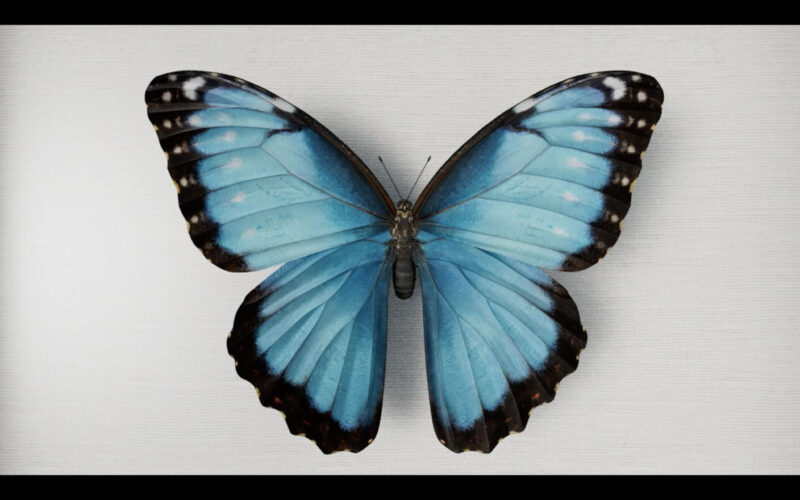BECCA MARTIN-BROWN
bmartin@nwaonline.com
Artists Susannah Sayler and Edward Morris describe their multimedia works currently showing at the Momentary as “monuments of a sort.”
“By calling them monuments, we are asking: ‘What if we had monuments to different species instead of men on horseback?’ What values could such monuments express for our society?”
In the case of “Prophecy of Butterflies” and “Eclipse,” Sayler and Morris want to capture nature’s iconic beauty in two phases — one that is endangered and one that is already lost.
“‘Prophecy’ is all color. It is playful, calm, dreamlike,” the duo say in an email interview. “‘Eclipse’ is more elegiac and is stark black and white. ‘Eclipse’ is, after all, about a species that went completely extinct and entirely because of human actions. So there is a bit of a mournful tone to ‘Eclipse.’ But … there are ecstatic moments to ‘Eclipse’ as well.”
Sayler and Morris’ installations are part of an exhibition titled “Enduring Amazon: Life and Afterlife in the Rainforest,” which remains on view through April 14. The exhibition explores the delicate balance of life in the Amazon rainforest through their work plus photography by Richard Mosse, music by Ben Frost and the work of environmental explorer David Brooks.
Here’s part of what Sayler and Morris had to say in an email Q&A.
Q. Which came first, the passion for ecology or the passion for creating by way of photography, video and writing?
A. We were each doing different things before we started making art collaboratively. Ed was a private investigator and before that a translator of Japanese poetry, while Susannah was an artist and photographer just graduating from an MFA program. So our passions for art and writing did preexist our passion for ecology. However, they did not combine and really take form as a collaboration between us until we were motivated to address the climate crisis. This was in 2006.
Q. How did those passions merge?
A. In 2006 we read a series of articles by Elizabeth Kolbert about the climate crisis, which later became the basis of the book “Field Notes from a Catastrophe.” These articles really shook us. They showed us how climate scientists had become deeply alarmed about some of the things they were seeing through their research. Kolbert was going to all these places, both far flung and nearby, and reporting on what scientists were looking at and why this was causing them so much concern — a truly existential level of concern.
In this way, Kolbert really brought home the discrepancy between scientific understanding of climate change and public understanding of the issue at the time and how that was leading to a lack of political will. We were compelled to do something to try and close this gap. Our solution was to combine our skills and follow what Kolbert had done with her writing but to use photographs. …
Q. What will viewers see in “Prophecy of the Butterflies”? Give us a little taste of the experience, please?
A. We really want to embody both the surprise and transcendent beauty of butterflies. The butterflies appear as the language the forest speaks to convey its dreams — dreams that will long outlast humans.
First, a few stray Blue Morpho butterflies arrive on an abstract landscape that suggests the Amazon forest. These butterflies are iconic to the Amazon and are also featured in a famous painting by Martin Johnson Heade that is in Crystal Bridges’ collection. Then more and more morphos being to appear, in surreal numbers. They begin to cluster together and form a circle. Then new butterfly species begin to emerge from within the circle; then more and more in all sorts of colors and shapes. They completely take over the screen, almost like beautiful TV snow, or more to the point like the amazing landscapes of Gustav Klimt, a reference that was suggested by Elise Raborg at The Momentary. Then the butterflies begin settling into shapes and coming to a rest. There they sit for a spell, seemingly trying to send the viewers a message. Then they begin to leave in the reverse order of how they arrived. After the last few Blue Morphos depart, the piece loops seamlessly and begins again. The piece cycles like this in an endless loop that is like breathing.
__
FAQ
‘Enduring Amazon: Life And Afterlife In The Rain Forest’
WHEN — Through April 14; hours are 10 a.m.-6 p.m. Tuesday-Thursday & Sunday, until 8 p.m. Friday-Saturday
WHERE — The Momentary, 507 S.E. “E” St. in Bentonville
COST — Free
INFO — themomentary.org



